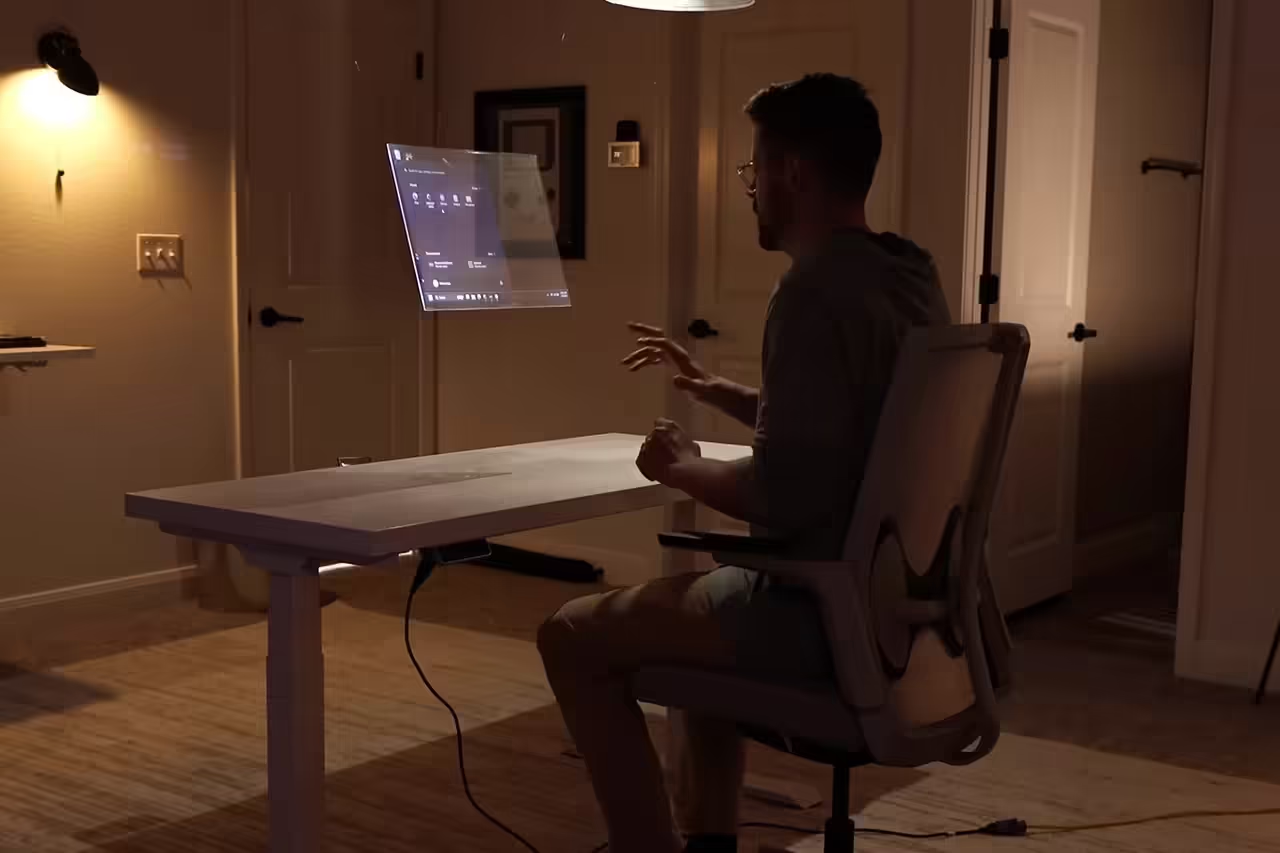
In the ever-evolving landscape of technology, we are constantly pushing the boundaries of what is possible. One such innovation that has captured the imagination of tech enthusiasts and futurists alike is the Holographic PC. Imagine a computer that brings holographic interfaces to life, transforming the way we interact with digital content. This article serves as an introduction to this groundbreaking technology and explores its significance in our digital world.
Unveiling the Holographic PC
A Holographic PC, often referred to as a “holographic computer” or “holographic interface,” is a cutting-edge computing system that integrates holography to create immersive, interactive experiences. Unlike traditional computers with flat screens, the Holographic PC leverages holographic projection technology to display 3D, lifelike images and interfaces that seemingly float in the air.
The key component of a Holographic PC is the ability to project holograms into physical space, allowing users to interact with digital content in a more natural and intuitive manner. This technology utilizes advanced sensors and cameras to track user gestures, eye movements, and voice commands, enabling a seamless interface between the physical and digital realms.
Relevance in the Digital Age
The Holographic PC is not just a novel concept; it represents a fundamental shift in the way we interact with computers and digital information. Here are some key aspects of its relevance:
Immersive Computing: Holographic PCs provide a level of immersion that traditional screens simply cannot match. Whether it’s for gaming, design, or professional applications, the ability to manipulate 3D holographic objects enhances the user experience and productivity.
Natural Interaction: With the integration of gesture recognition and voice commands, Holographic PCs offer a more natural and intuitive way to interact with technology. Users can manipulate objects with their hands or communicate with the computer in a conversational manner.
Spatial Computing: Holographic PCs make use of spatial computing, allowing digital content to be seamlessly integrated into the physical environment. This opens up a myriad of possibilities for applications in fields like architecture, education, and healthcare.
Collaboration and Communication: These holographic systems facilitate remote collaboration by projecting participants as lifelike holograms into virtual meeting spaces. It enhances teamwork and communication, regardless of physical distances.
Innovation and Creativity: Creatives, designers, and developers can explore new horizons in their work. Holographic PCs allow for the creation, modification, and manipulation of 3D content with unparalleled precision.
Education and Training: Holographic PCs have the potential to revolutionize education and training by offering interactive and immersive learning experiences. From dissecting virtual biology specimens to practicing surgery in a risk-free environment, the possibilities are limitless.
How the Holographic PC Works: A Detailed Explanation
The Holographic PC is a fascinating piece of technology that operates on a combination of several cutting-edge components and principles to create immersive 3D holographic experiences.
Holographic Projection Technology:
At the heart of the Holographic PC is the holographic projection technology. It works by projecting light onto a surface to create a 3D image that appears to be suspended in mid-air. This technology employs a variety of techniques such as diffractive optics, laser projection, and interference patterns to produce these holographic visuals.
Depth-Sensing Cameras:
A crucial element in the Holographic PC is the depth-sensing cameras. These cameras capture the user’s physical environment and movements in real-time. Microsoft’s HoloLens, for example, uses a set of cameras that detect depth, allowing the device to understand and interact with the surrounding space.
Sensors and Tracking:
The Holographic PC is equipped with an array of sensors, including accelerometers and gyroscopes, to precisely track the movement and orientation of the user. These sensors are crucial for ensuring that holographic objects remain stable and aligned with the user’s perspective.
Augmented Reality (AR) Software:
Holographic PCs rely on specialized augmented reality software to render and display holographic content. This software integrates the data from the depth-sensing cameras and sensors to create a real-time, spatially aware environment. It’s this software that enables the computer to understand the user’s gestures and voice commands, making interaction more intuitive.
Optics and Projection Surfaces:
The optics system within a Holographic PC is responsible for directing the projected images towards the user’s eyes. High-quality optical components ensure that the holograms are clear, crisp, and properly aligned. Some devices use beam-splitting optics to combine the digital holographic content with the real-world view.
Gestural Interface:
One of the most remarkable features of Holographic PCs is their ability to recognize and respond to gestures. This is made possible by the combination of depth-sensing cameras and software that interprets hand movements and other physical cues. Users can interact with holographic objects by reaching out, touching, or manipulating them using gestures.
Voice Commands:
Voice recognition technology is another integral part of the Holographic PC’s interface. Users can control and manipulate holographic content through voice commands. This voice recognition technology, often powered by AI, allows for natural and hands-free interaction with the holographic environment.
Spatial Mapping:
The Holographic PC creates a digital map of the physical space in real-time. This is essential for ensuring that holographic objects appear correctly within the user’s environment, avoiding collisions with real-world objects and surfaces.
Holographic Rendering:
Holographic PCs utilize advanced rendering techniques to create 3D holographic content. This content can include everything from holographic user interfaces to 3D models, videos, and interactive applications. The rendering is done in real-time, and the software continually adjusts the position and appearance of holographic elements as the user moves.
History of Holographic Projection Technology in Computing: An Overview
The history of holographic projection technology in computing is a fascinating journey that spans decades of innovation and technological advancements. This article provides a brief overview of the evolution of holographic projection within the realm of computer science.
The Early Roots:
Holography, the science of creating and displaying holograms, was first developed by Hungarian-British physicist Dennis Gabor in 1947. Gabor’s groundbreaking work laid the foundation for holography, although it wasn’t initially intended for computer applications. Instead, it found early use in microscopy and electron microscopy, making it possible to create 3D-like images.
Emergence in Scientific Research:
Holography gained popularity in scientific research, particularly in fields such as fluid dynamics and structural analysis. Scientists used holography to visualize complex structures and phenomena in three dimensions, which greatly aided in their studies.
Computing and Holography Converge:
The 1970s and 1980s saw the first significant attempts to merge computing with holography. Early computer-generated holography (CGH) research began to emerge, allowing computers to generate holographic images. However, these systems were often slow and required extensive computational resources.
Advancements in Holographic Displays:
In the late 20th century, there were significant breakthroughs in holographic display technology. Researchers started exploring how to project 3D holographic images and interfaces that users could interact with. These developments opened the door to various applications, including medical imaging and data visualization.
Early Commercialization:
The late 1990s and early 2000s witnessed the first commercial attempts to bring holographic technology to consumers. Companies like Zebra Imaging started producing holographic prints and displays. Still, these early products were primarily aimed at specialized markets, such as architectural visualization.
Microsoft’s HoloLens:
A major milestone in the history of holographic projection in computing was the release of Microsoft’s HoloLens in 2016. The HoloLens was one of the first consumer-level devices to combine augmented reality (AR) and holographic projection. It featured depth-sensing cameras and advanced optics to project holographic content into the user’s field of view. This marked a significant step toward merging computing with holography for everyday applications.
Continued Advancements:
Since the introduction of the HoloLens, the technology has continued to advance rapidly. Companies and researchers are exploring applications in fields as diverse as healthcare, education, entertainment, and design. The use of spatial computing and natural user interfaces has made holographic technology increasingly intuitive and accessible.
Components of a Holographic PC
Central to a Holographic PC is the holographic projection technology. This technology projects light in a way that creates 3D holographic images that appear to float in the air. It utilizes advanced techniques like diffractive optics, laser projection, and interference patterns.
Depth-Sensing Cameras:
These cameras capture the user’s physical environment in real-time. They provide data about the depth and dimensions of the space, allowing the computer to understand the user’s surroundings and movements accurately.
Sensors and Tracking Systems:
Holographic PCs incorporate a range of sensors, including accelerometers and gyroscopes, to track the movement and orientation of the user. These sensors ensure that the holographic content remains aligned with the user’s perspective.
Augmented Reality (AR) Software:
Specialized augmented reality software is responsible for rendering and displaying holographic content. It integrates data from the depth-sensing cameras and sensors to create a real-time, spatially aware environment. This software is essential for user interaction and creating an immersive experience.
Optics and Projection Surfaces:
The optics system is critical for directing the projected holographic images towards the user’s eyes. High-quality optical components ensure that the holograms are clear and well-aligned with the physical space. Some devices use beam-splitting optics to combine digital holographic content with the real-world view.
Gestural Interface:
One of the most notable features of Holographic PCs is the ability to recognize and respond to gestures. This capability is made possible through the combination of depth-sensing cameras and software that interprets hand movements and other physical cues. Users can interact with holographic objects by reaching out, touching, or manipulating them using gestures.
Voice Recognition Technology:
Voice commands are a fundamental part of the user interface of a Holographic PC. Users can control and manipulate holographic content through voice commands. Sophisticated voice recognition technology, often powered by artificial intelligence (AI), enables natural and hands-free interaction with the holographic environment.
Spatial Mapping:
Holographic PCs create digital maps of the physical space in real-time. This mapping is crucial for ensuring that holographic objects appear correctly within the user’s environment, preventing collisions with real-world objects and surfaces.
Holographic Rendering Technology:
To create the 3D holographic content, Holographic PCs utilize advanced rendering techniques. This content can include holographic user interfaces, 3D models, videos, and interactive applications. The rendering is done in real-time, adjusting the position and appearance of holographic elements as the user moves.







